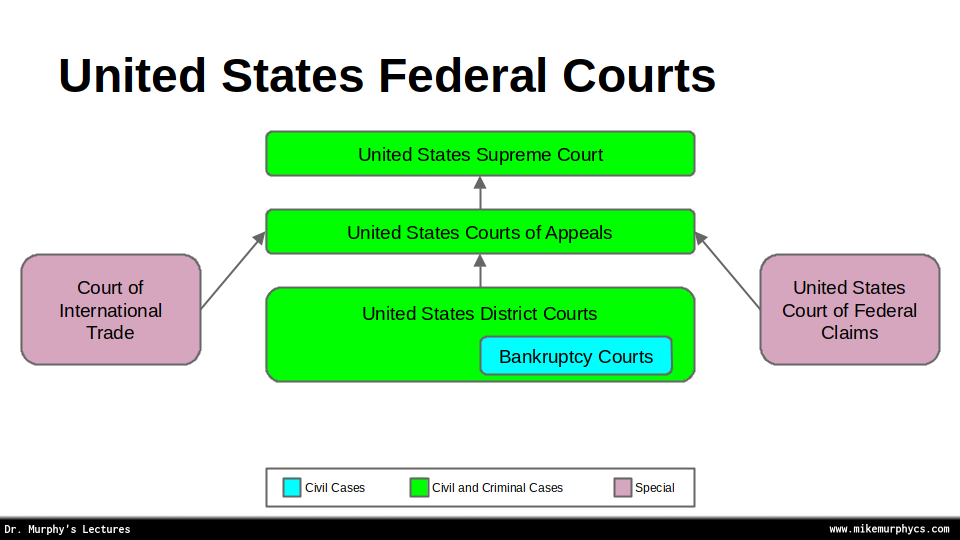Federal Court System
The United States federal court system is established by Article III, Section 1 of the United States Constitution:1
“The judicial Power of the United States, shall be vested in one supreme Court, and in such inferior Courts as the Congress may from time to time ordain and establish.”
Over the years, Congress has established a hierarchy of federal courts, with trial courts at the bottom, appellate courts in the middle, and the Constitutionally-mandated Supreme Court at the top.
Video Lecture
Organization of the Federal Courts
As shown in Figure 1, the federal court system is organized into a hierarchy of trial and appellate courts. The trial courts, or District Courts, are at the bottom of the hierarchy. Appeals from the trial courts may be heard in the Appellate Courts. Further appeals may then be heard by the Supreme Court, which is the highest court in the nation. Two additional special courts exist at the trial level: the Court of International Trade, and the Court of Federal Claims.
Within the District Courts, there are special Bankruptcy Courts that handle civil bankruptcy matters. Otherwise, the District Courts generally handle both civil and criminal cases.

The Supreme Court of the United States
Frequently abbreviated SCOTUS, the Supreme Court of the United States is the highest federal court in the nation. It consists of nine justices, one of whom serves as Chief Justice, while the others serve as Associate Justices. Members of the Supreme Court are appointed by the President of the United States and confirmed by the United States Senate. They serve lifetime terms on the court.
Most of the Supreme Court’s work concerns its appellate jurisdiction, where it hears cases that are appealed from the United States Courts of Appeals. However, the Supreme Court also has original jurisdiction for all cases involving ambassadors, public ministers and consuls, and those in which any of the U.S. states are a party. (U.S. Constitution, Article III, Section 2)
In order for the Supreme Court to hear a case, a person or entity must petition the court. This person is normally called the petitioner. If any four of the justices agree to the petition, the court issues a writ of certiorari, and the case is heard by the full court. On average, the Supreme Court receives approximately 7,000 to 8,000 petitions per year, but it only grants certiorari to about 80 cases each term.2
United States Courts of Appeals
As the name implies, the United States Courts of Appeals have only appellate jurisdiction, receiving appeals from the trial courts beneath them (see Figure 1) as well as appeals of decisions made by federal administrative agencies. Groups of states are divided into regions, or circuits, and there is a single Court of Appeals for each circuit. There is also a specialized Court of Appeals for the Federal Circuit, which handles certain types of cases.
Appeals from federal cases in South Carolina are heard by the Fourth Circuit Court of Appeals, located in Richmond, Virginia.
United States District Courts
The United States District Courts are the primary trial courts at the federal level. These courts have original jurisdiction for the vast majority of federal cases, both civil and criminal. In addition, each District Court has its own Bankruptcy Court, which is a special court unit for handling cases where a person or entity is insolvent and is trying to reorganize or discharge debts owed to someone else.
Judges in the District Courts are divided into two groups: District Judges and Magistrates. District Judges are nominated by the President of the United States and confirmed by the United States Senate. Each district’s District Judges elect the federal Magistrates for that district. Magistrate judges have authority over limited matters as prescribed by statute or as directed by the District Judges.
There is a single federal District of South Carolina, which contains the District Court with jurisdiction over federal matters within the state. Cases are heard in courtrooms in Aiken, Anderson, Beaufort, Charleston, Columbia, Florence, Greenville, and Spartanburg. Clerk of Court offices are located in Charleston, Columbia, Florence, and Greenville.
Special Trial Courts
Several special trial courts exist in parallel with the District Courts. These include the Court of International Trade and the United States Court of Federal Claims. The Court of International Trade handles cases involving the movement of goods into and out of the United States, or issues arising with U.S. Customs as a result of such trade. The United States Court of Federal Claims has original jurisdiction over most claims in which the federal government is named as the defendant, including disputes involving federal contracts.
Notes and References
-
United States Constitution. Library of Congress. ↩
-
Frequently Asked Questions: General Information. Supreme Court of the United States. ↩
